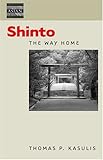Shinto : The Way Home / Thomas P. Kasulis.
Material type: TextSeries: Dimensions of Asian Spirituality ; 21Publisher: Honolulu : University of Hawaii Press, [2004]Copyright date: ©2004Description: 1 online resource (208 p.)Content type:
TextSeries: Dimensions of Asian Spirituality ; 21Publisher: Honolulu : University of Hawaii Press, [2004]Copyright date: ©2004Description: 1 online resource (208 p.)Content type: - 9780824827946
- 9780824864309
- 299.5/61 22
- BL2220 .K38 2004
- online - DeGruyter
- Issued also in print.
| Item type | Current library | Call number | URL | Status | Notes | Barcode | |
|---|---|---|---|---|---|---|---|
 eBook
eBook
|
Biblioteca "Angelicum" Pont. Univ. S.Tommaso d'Aquino Nuvola online | online - DeGruyter (Browse shelf(Opens below)) | Online access | Not for loan (Accesso limitato) | Accesso per gli utenti autorizzati / Access for authorized users | (dgr)9780824864309 |
Browsing Biblioteca "Angelicum" Pont. Univ. S.Tommaso d'Aquino shelves, Shelving location: Nuvola online Close shelf browser (Hides shelf browser)

|

|

|

|

|

|

|
||
| online - DeGruyter Shaping History : The Role of Newspapers in Hawaii / | online - DeGruyter Sherlock in Shanghai : Stories of Crime and Detection by Cheng Xiaoqing / | online - DeGruyter Shifting Shape, Shaping Text : Philosophy and Folklore in the Fox Koan / | online - DeGruyter Shinto : The Way Home / | online - DeGruyter Significant Other : Staging the American in China / | online - DeGruyter Sitings : Critical Approaches to Korean Geography / | online - DeGruyter Snakes' Legs : Sequels, Continuations, Rewritings, and Chinese Fiction / |
Frontmatter -- Contents -- Editor's Preface -- Preface -- Acknowledgments -- Introduction -- CHAPTER 1. Entering Through the Torii -- CHAPTER 2. Everyday Connectedness -- CHAPTER 3. Ancient Shinto (Prehistory-794) The Trailblazers -- CHAPTER 4. From Nara to Norinaga (794-1801) The Pathfinders -- CHAPTER 5. All Roads Lead to Tokyo (1801-2002) The Highway Engineers -- CHAPTER 6. The Way Home -- Appendix: Pronouncing Japanese Names and Terms -- Further Reading -- Index -- About the Author
restricted access online access with authorization star
http://purl.org/coar/access_right/c_16ec
Nine out of ten Japanese claim some affiliation with Shinto, but in the West the religion remains the least studied of the major Asian spiritual traditions. It is so interlaced with Japanese cultural values and practices that scholarly studies usually focus on only one of its dimensions: Shinto as a "nature religion," an "imperial state religion," a "primal religion," or a "folk amalgam of practices and beliefs." Thomas Kasulis' fresh approach to Shinto explains with clarity and economy how these different aspects interrelate.As a philosopher of religion, he first analyzes the experiential aspect of Shinto spirituality underlying its various ideas and practices. Second, as a historian of Japanese thought, he sketches several major developments in Shinto doctrines and institutions from prehistory to the present, showing how its interactions with Buddhism, Confucianism, and nationalism influenced its expression in different times and contexts. In Shinto's idiosyncratic history, Kasulis finds the explicit interplay between two forms of spirituality: the "existential" and the "essentialist." Although the dynamic between the two is particularly striking and accessible in the study of Shinto, he concludes that a similar dynamic may be found in the history of other religions as well. Two decades ago, Kasulis' Zen Action/Zen Person brought an innovative understanding to the ideas and practices of Zen Buddhism, an understanding influential in the ensuing decades of philosophical Zen studies. Shinto: The Way Home promises to do the same for future Shinto studies.
Issued also in print.
Mode of access: Internet via World Wide Web.
In English.
Description based on online resource; title from PDF title page (publisher's Web site, viewed 02. Mrz 2022)


